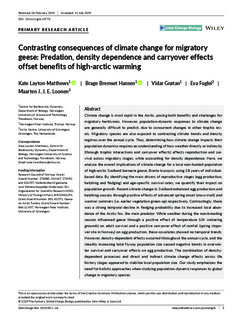| dc.description.abstract | Climate change is most rapid in the Arctic, posing both benefits and challenges for migratory herbivores. However, population‐dynamic responses to climate change are generally difficult to predict, due to concurrent changes in other trophic levels. Migratory species are also exposed to contrasting climate trends and density regimes over the annual cycle. Thus, determining how climate change impacts their population dynamics requires an understanding of how weather directly or indirectly (through trophic interactions and carryover effects) affects reproduction and survival across migratory stages, while accounting for density dependence. Here, we analyse the overall implications of climate change for a local non‐hunted population of high‐arctic Svalbard barnacle geese, Branta leucopsis, using 28 years of individual‐based data. By identifying the main drivers of reproductive stages (egg production, hatching and fledging) and age‐specific survival rates, we quantify their impact on population growth. Recent climate change in Svalbard enhanced egg production and hatching success through positive effects of advanced spring onset (snow melt) and warmer summers (i.e. earlier vegetation green‐up) respectively. Contrastingly, there was a strong temporal decline in fledging probability due to increased local abundance of the Arctic fox, the main predator. While weather during the non‐breeding season influenced geese through a positive effect of temperature (UK wintering grounds) on adult survival and a positive carryover effect of rainfall (spring stopover site in Norway) on egg production, these covariates showed no temporal trends. However, density‐dependent effects occurred throughout the annual cycle, and the steadily increasing total flyway population size caused negative trends in overwinter survival and carryover effects on egg production. The combination of density‐dependent processes and direct and indirect climate change effects across life history stages appeared to stabilize local population size. Our study emphasizes the need for holistic approaches when studying population‐dynamic responses to global change in migratory species. | nb_NO |

